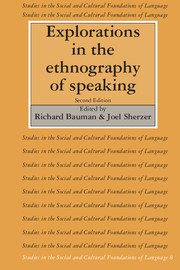Book contents
- Frontmatter
- Contents
- INTRODUCTION TO THE SECOND EDITION
- I PREFACE AND INTRODUCTION
- II COMMUNITIES AND RESOURCES FOR PERFORMANCE
- III COMMUNITY GROUND RULES FOR PERFORMANCE
- IV SPEECH ACTS, EVENTS, AND SITUATIONS
- Introduction
- 8 Strategies of Status Manipulation in the Wolof Greeting
- 9 Rituals of Encounter among the Maori: Sociolinguistic Study of a Scene
- 10 Speaking of Speaking: Tenejapa Tzeltal Metalinguistics
- 11 Black Talking on the Streets
- 12 Namakke, Sunmakke, Kormakke: Three Types of Cuna Speech Event
- 13 The Concept and Varieties of Narrative Performance in East European Jewish Culture
- V THE SHAPING OF ARTISTIC STRUCTURES IN PERFORMANCE
- VI TOWARD AN ETHNOLOGY OF SPEAKING
- Notes
- References
- Index of names
10 - Speaking of Speaking: Tenejapa Tzeltal Metalinguistics
Published online by Cambridge University Press: 05 June 2012
- Frontmatter
- Contents
- INTRODUCTION TO THE SECOND EDITION
- I PREFACE AND INTRODUCTION
- II COMMUNITIES AND RESOURCES FOR PERFORMANCE
- III COMMUNITY GROUND RULES FOR PERFORMANCE
- IV SPEECH ACTS, EVENTS, AND SITUATIONS
- Introduction
- 8 Strategies of Status Manipulation in the Wolof Greeting
- 9 Rituals of Encounter among the Maori: Sociolinguistic Study of a Scene
- 10 Speaking of Speaking: Tenejapa Tzeltal Metalinguistics
- 11 Black Talking on the Streets
- 12 Namakke, Sunmakke, Kormakke: Three Types of Cuna Speech Event
- 13 The Concept and Varieties of Narrative Performance in East European Jewish Culture
- V THE SHAPING OF ARTISTIC STRUCTURES IN PERFORMANCE
- VI TOWARD AN ETHNOLOGY OF SPEAKING
- Notes
- References
- Index of names
Summary
The intent of this paper is to present a picture of the ways that Tzeltal (Maya) speakers themselves categorize their world of verbal communication, the ways that they talk about speech events occurring in their own cultural matrix. Instead of outlining a tightly defined and highly structured cultural domain and analyzing it exhaustively in terms of defining components on each level of contrast, I want to let the native terms and their glosses along with some explanation speak for themselves. There are two reasons for adopting this expository stance.
The first is that the meanings of the native terms as glossed embody the attributes of communicative events that we must assume the Tzeltal speakers single out as relevant and significant in specific situations. Thus, by simple inspection we can see what kinds of events the Tzeltal have chosen to label, what components and functions of speaking are focused on (cf. Hymes 1962), and what attributes of individual speech and speaking style are considered important enough to deserve names. In other words, I have not sought a single grammatical or social frame for generating a universe of discourse and analysis because a priori levels of organization are unnecessary at this point for an understanding of fundamental Tzeltal conceptualizations of verbal interaction.
The second, and more important reason, is that elicitation frames and abstract analysis would be more likely to obscure than to clarify the metalinguistic picture under consideration.
- Type
- Chapter
- Information
- Explorations in the Ethnography of Speaking , pp. 213 - 239Publisher: Cambridge University PressPrint publication year: 1989
- 3
- Cited by



